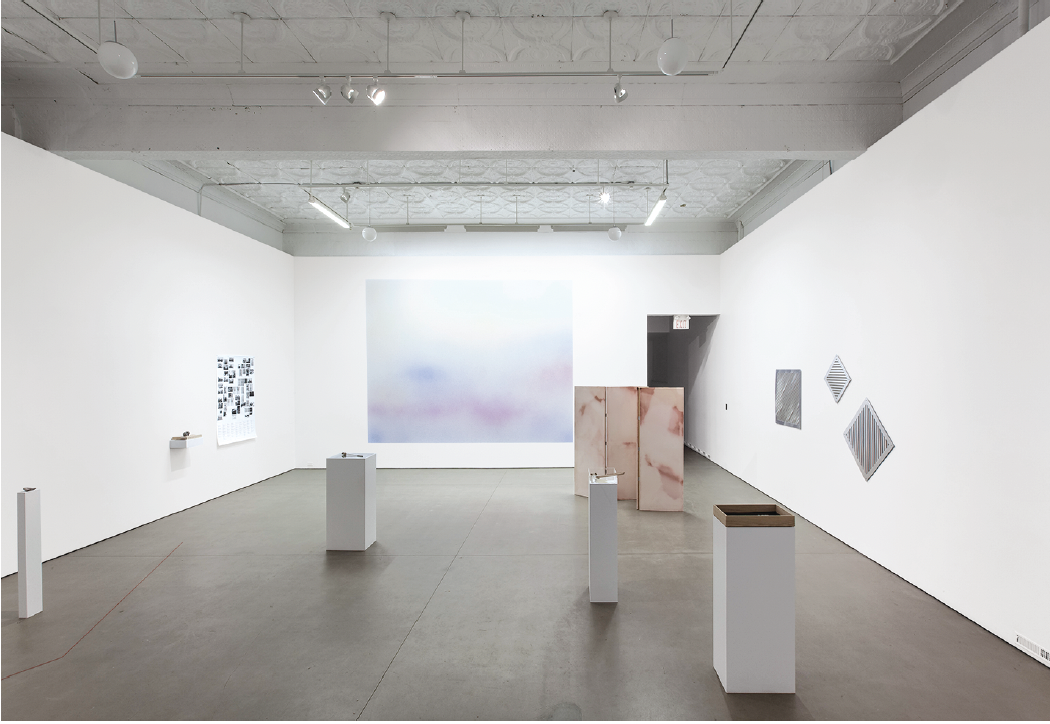“Hapax Legomena”
The exhibition, a 10-person group show titled “Hapax Legomena” at Mercer Union, translates to “things that occur only once” and refers to a series of films of the same name by the artist Hollis Frampton. Curated by Yoann Gourmel and Elodie Royer this exhibition seems to begin in mid-sentence, follows many different paths and connects to other artists, places and art historical pasts. Benoît-Marie Moriceau’s work comprises ordinary objects, such as a billiard ball, film canister or bottle. According to the exhibition’s guide, each object carries some special significance and a curious (perhaps even fictional) history. (Was the bottle really bought in 1941, at the current location of Mercer Union?) Installed behind highly reflective glass in the gallery’s windows, these objects remain hidden until they are momentarily illuminated by small overhead lights set on timers. Limited to these brief exposures, things occur once and then, after a short time, they occur again. By infusing breaks and stoppages, the work in this exhibition emerges as a series of unique events, allowing for an exploration of the subtle ways in which things change and morph, even when they do not seem to change at all. For example, Raisonné of Rhombicuboctahedra, 2012, catalogues Raphaël Zarka’s ongoing photographic collection of streetlights, architectural elements and other common, everyday objects that are found in the geometrical shape of a rhombicuboctahedron. Meanwhile, Benoît Maire investigates how disparate objects can strangely coexist in the multi-piece installation Arma Ohne Warum, 2012, which includes a number of works on plinths, a video and a wall piece. The latter presents a suspended, broken, carpenter’s wooden folding ruler that snakes diagonally across the wall, with a photograph of a plant extending from its stem, covered with layers of broken sheets of glass. The artist encourages the inanimate and the organic to expand into one another; he elicits loose collaborations locked into delicate oppositions. Within the installation, we find various other measuring tools, which have been altered, broken or dislodged from their normal use. Yet they still measure, just like an artwork still functions as an artwork even when appearing as a non-functional object.

“Hapax Legomena,” installation view, Mercer Union, Toronto, September 14 to October 20, 2012. Courtesy Mercer Union Centre for Contemporary Art, Toronto. Photograph: Toni Hafkenscheid
Mark Geffriaud’s work Shelter (Contrechamp), 2012, seems to be nothing more than a functional object: a light switch located innocuously between the two spaces of the gallery, which, when pressed, changes the light configuration from the standard gallery fluorescents and spots to hanging globe lights. The exchange of lights can, in itself, completely alter the functioning of a room, as when lights dim at the cinema; here, the exhibition itself flickers like an old projector. This work not only reactivates the space, it converts the space, from art into real life and back to art again. Shelter is part of a series of site-specific installations of windows, stairs and other components of a home that the artist will eventually build for himself and his family.
Julien Crépieux’s work also makes use of the relationship between the space of an artwork and a domestic space. The black and white film, Microfilm, 2012, presents television monitors constantly repositioned within the confines of an empty house, which together screen the entire film Pickup on South Street, 1953. In Crépieux’s version, every cut, every camera angle of the original film is emulated. When the original film presents a figure standing in a brightly lit space near a window, in Microfilm the monitor on which this scene is shown is itself positioned beside a window in the attic of the house. As the film’s camera cuts back and forth between two characters immersed in a heated discussion, so too does Crépieux’s camera, between two opposing monitors. One may lose sight of the narrative of the film and follow instead what is usually hardly visible: the very specific and deliberate formal language of film, as if one were given special insight into seeing what a cinematographer sees. Throughout, the presence of the empty house is inescapable, and this not only frames the film’s whole domain but becomes that uncomfortable other object, which does not fully fit into the artist’s predefined conditions. The viewer no longer just watches a double articulation; there are moments and instances where something slips out of this bind, where they no longer fit into this system. The strength of this exhibition lies in how each work is a transition to another work, to another reality, and at the same time is able to transmit something of its own being, of its potentiality; where each work becomes like a looking glass, an apparatus to something else. In the case of Crépieux’s work, this series of transmissions finds its way to us, the no longer passive viewer sitting in a gallery’s screening room; our eyes, like the third camera, view the film within the film, participate in the film. As someone flips the switch and light starts to creep into the room, you may overhear a whisper, “you know this building that Mercer Union now occupies, well, it used to be a cinema.” ❚
“Hapax Legomena” was exhibited at Mercer Union Centre for Contemporary Art, Toronto, from September 14 to October 20, 2012.
Wojciech Olejnik is a multidisciplinary artist who currently lives and works in Toronto.

